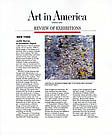A native of Miami, Judith Murray earned her MFA from the Pratt Institute in 1964 and immediately after studied at the Academia de Bellas Artes de San Fernando, Madrid, Spain. In 1966, she served as the artist-in-residence for the United States Information Agency, and held her first one-person show with Betty Parsons in 1976. Other early events (?) included a one-person show at The Clocktower in 1978 and the inclusion of her work in the 1979 Whitney Biennial.
Murray's early work was small in size, her compositions austere. Comprised of a centered hard-edged geometric form or forms on a rich black field, they referenced the marine flora of her Florida home. In 1982, with a National Endowment for the Arts grant in painting, Murray transformed her style, which she revealed at her first one-person museum exhibition at the Dallas Museum of Fine Arts. No longer focused on the abstractness of form, she began using the entire canvas to explore the pleasures derived from an active brush stroke and the build-up of paint.
Through this change, Murray's work began to take on an atmospheric feel, revealing the natural world as a as sensation, as energy and flow. Murray uses a flat knife to first push the color into the canvas. Colors are then layered short, quick horizontal spurts, creating a complex web of marks that recalls the lapping of water over pebbles, light diffused through leaves. Although she uses a limited palette of red, black, white and yellow, their layering and repetition reveals infinite subtleties.
While the surfaces have changed, their production and format has remained largely the same. The dappled color gives the compositions a horizontality that is countered by the always-present vertical bar on the left side of the canvas.
By 1997, she was creating her largest paintings – some reaching 8 feet by 9 feet. As Murray herself has said about scale, " It's the relationship between my physicalness and its (the canvas') physicalness."
The eye probes the surface for what might be underneath.
Her images have energy and flow, an inner glow that meets with external light to create a glowing translucency. Colors are capable of infinite subtleties. Sublime quality. Textures – sand, wall, patina. Time- building up over time. Complexity of abstraction.
An extensive traveler, Murray divides most of her time between studios in Big Pine Key, Florida and New York. The time she spends in the Florida keys is absorbed into her surfaces – there is a stillness silence, sounds, the look of the land, and above all, the searing radiance, the breathlessness of air, the bleached and blasted tree trunks gilded by sun.
At the right edge of each painting, is a bar that extends from top to bottom; it has appeared in all of her paintings, emphasizing their origins in paint, their identity as uncompromised, uncompromising abstraction. Activates the space for internal imagery. Its effect is to shift the focus of the painting from the center but is also possibly a principle standing for rationality. Murray admits that, "it pulls the forms off center and gives them a structure to rock against and grow towards."
The build up of surfaces is a nod to the concept of time – as are her titles. With most titles suggested by Wallace Stevens, her titles acknowledge their sources in the poetics of place. As Murray says, "Each painting finds its own identity. After I finish a work I sit before it and find the words that fit. Nothing in my work is arbitrary."
Murray has been commissioned by the Lincoln Center for the Performing arts to create a poster and print for the Mostly Mozart Festival in 1981, 1986, and 1991. Her work is included in the permanent collections of Honolulu Academy of Art, Honolulu, Hawaii, National Museum of Art, Warsaw, Poland. The Brooklyn Museum, New York, NY.
Her most recent one-person exhibition was at P.S1 Contemporary Art Center. She currently is the 2002 Guggenheim Fellow.
Her early work was spare, assertive, its empty fields inhabited by a few hard-edged geometric figures that suggested exotic sea creatures or decadent, even dangerous plants, spiked by thin, bladed arcs, leafed by daggers. Earlier the elements were linear and spare and remided one of sea life (Murray grew up in Miami) as well as symbols from the unconscious. Paintings of the 1980s were more closely allied to hard-edged abstractions suggesting fantastical erotic flora.

